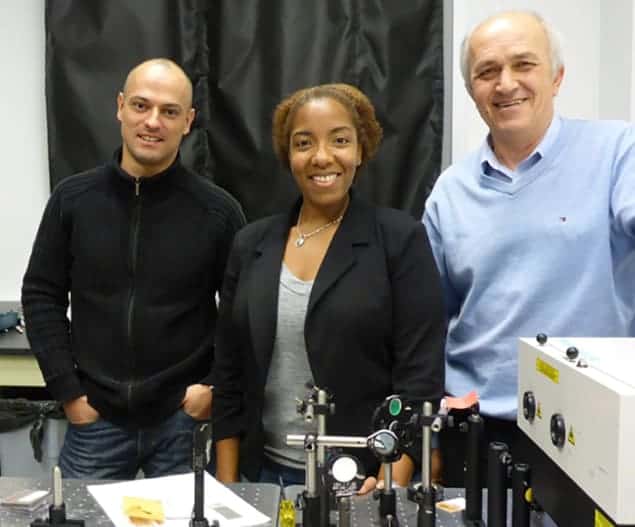
Quantum dots made of pure selenium can be made by simply firing a laser beam at selenium powder mixed into a glass of water. The easy and inexpensive process was developed by researchers at the University of Texas at San Antonio and Northeastern University in the US, and unlike other techniques, does not involve potentially toxic chemicals. The high-quality nanostructures could be used in two very different applications: as antibacterial agents and as light harvesters in solar cells.
Quantum dots are tiny pieces of semiconductor – such as selenium – that are typically tens of nanometres across. The size of a quantum dot dictates how their charge-carrying electrons and holes interact with light. As a result, they are of great interest to researchers trying to develop photonic technologies and especially solar cells. However, growing quantum dots that are pure and all the same size can be a challenge.
Green and easy
The researchers, led by Gregory Guisbiers in San Antonio, created their pure selenium quantum dots using a technique called pulsed laser ablation in liquids (PLAL), which involves simply firing a pulsed laser beam at a target – in this case selenium powder in water. “Our method is ‘green’ because it does not involve any dangerous solvents, only water, and there are no toxic adducts or by-products, like those often encountered in many wet chemistry processes,” explains Guisbiers. “It is also cheap and easy because we do not need a vacuum chamber or clean room – everything is done in a beaker of water.” The pure nanoparticles produced are also easy to collect and store because they are directly synthesized in solution, he adds.
This is the first time that selenium quantum dots have been synthesized using PLAL at ultraviolet and visible wavelengths, he says. These wavelengths are particularly interesting because they are better at reducing the size of particles compared with light at near-infrared wavelengths. Guisbiers and colleagues also showed that the crystallinity of the nanoparticles created by this technique depends on their size – that is, the smallest particles are crystalline while the largest ones are amorphous.
Antibacterial and anti-cancer
Selenium nanoparticles have antibacterial and anti-cancer properties, and could be used in medicine because the material is biocompatible and already exists in our bodies. However, nanoparticles need to be free of surface contaminants if they are to be employed in a biomedical setting – something that has proved difficult to achieve in the past.
The team, which has already tested its nanoparticles on E. coli, is now looking to see if they are efficient at killing other types of bacteria. “We are particularly interested in other bacteria involved in nosocomial diseases, like the methicillin-resistant Staphylococcus aureus,” Guisbiers says. “I’m told that [hospital-acquired infections] cause roughly 100,000 deaths every year in the US alone because bacteria are becoming more and more resistant to existing antibiotics. What’s more, these so-called super-germs are spreading worldwide, making this a major international health concern.”
The researchers will report their work in an upcoming issue of Laser Physics Letters. The team is also planning to incorporate the pure selenium quantum dots that they made into third-generation solar cells. “Indeed, since the element itself is a p-type semiconductor, when combined with an n-type semiconductor, we can build p–n junctions (the building blocks of all modern-day electronics) at the nanoscale,” adds Guisbiers.
- This article first appeared on nanotechweb.org



